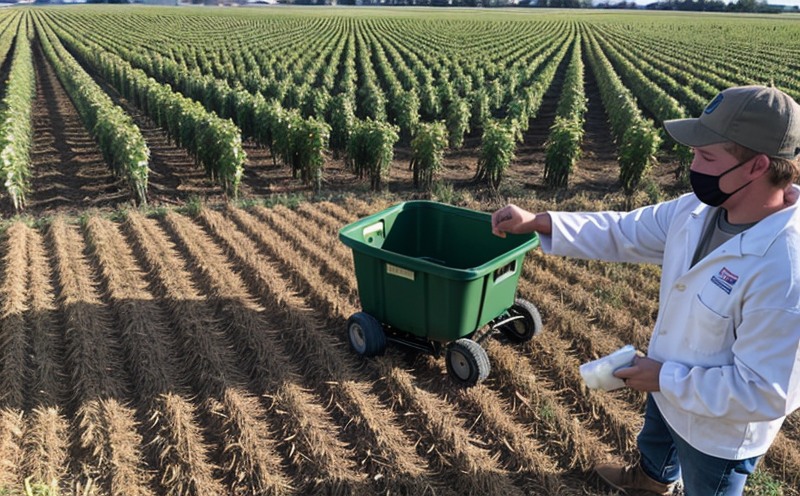Sensory Quality Testing in Harvested Produce
Sensory quality testing in harvested produce is a critical component of ensuring high-quality agricultural and forestry products reach consumers. This service evaluates the sensory attributes that contribute to consumer acceptance, such as color, flavor, texture, aroma, and appearance. These attributes are essential for maintaining market competitiveness and satisfying customer expectations. In agriculture and forestry, post-harvest quality testing plays a pivotal role in ensuring that produce meets specific standards before it reaches the retail shelf or export markets. The sensory qualities of fruits, vegetables, nuts, and other harvested products can significantly impact consumer satisfaction and brand reputation. Our laboratory specializes in providing comprehensive sensory quality assessments using advanced technologies and methodologies. To perform sensory quality testing effectively, a multidisciplinary approach is employed, involving experts from various fields including food science, botany, horticulture, and sensory evaluation. This ensures that the tests are both accurate and reliable, reflecting real-world consumer expectations. The process typically involves selecting representative samples of produce, conducting controlled evaluations by trained panelists, and comparing results against established standards. The instrumentation used for this service includes digital colorimeters to measure color consistency, electronic noses and tongues for aroma and flavor analysis, texture analyzers for assessing firmness and elasticity, and sensory evaluation booths where trained individuals assess overall quality. These tools provide precise data that can be compared with international standards such as ISO 15667-2:2018, which outlines methods for evaluating color in agricultural products. Preparing specimens for sensory quality testing involves careful selection of samples to ensure they are representative of the entire batch or lot. Samples must be stored under controlled conditions to prevent any changes that could affect their sensory properties. During evaluation, panelists use standardized procedures to rate various aspects of the produce, which allows for consistent and accurate results. The importance of sensory quality testing cannot be overstated in today’s competitive market. Consumers increasingly demand high-quality products with consistent sensory attributes, driving the need for rigorous testing protocols. By leveraging this service, producers can ensure their offerings meet these demands while also enhancing brand loyalty and customer satisfaction.International Acceptance and Recognition
Sensory quality testing is widely recognized by international bodies as an essential component of agricultural and forestry product standards. Organizations such as the International Organization for Standardization (ISO) and the European Committee for Standardization (CEN) have established guidelines that mandate sensory evaluation as part of comprehensive quality assurance programs. ISO 15667-2:2018 specifically addresses methods for evaluating color in agricultural products, which is crucial for ensuring uniformity among batches. Similarly, EU regulations emphasize the importance of sensory characteristics when assessing the suitability of produce for human consumption. These standards not only enhance consumer confidence but also facilitate smoother trade between countries by setting common benchmarks. Our laboratory adheres strictly to these international norms and practices, ensuring that our test results are both credible and internationally accepted. By aligning with recognized protocols, we provide clients with consistent, reliable data that can be used in various contexts—from internal quality control to export documentation.Environmental and Sustainability Contributions
In the context of agriculture and forestry testing, sensory quality testing contributes positively to environmental sustainability by promoting efficient resource use and minimizing waste. By identifying produce that meets sensory criteria early in the process, farmers and processors can optimize their operations, reducing unnecessary handling or processing steps. Additionally, accurate sensory assessments help reduce food loss post-harvest by ensuring only high-quality items are marketed for consumption. This approach supports sustainable practices by encouraging responsible resource management throughout the supply chain. Our laboratory's commitment to environmental stewardship is reflected in our efforts to minimize energy consumption and waste generation during testing processes.Use Cases and Application Examples
- Fruit Quality Control: Evaluating the color, flavor, and texture of apples or oranges before they are shipped to supermarkets.
- Nutritional Value Assessment: Determining the aroma and taste profile of almonds or walnuts for export markets.
- Vegetable Sorting: Inspecting carrots or celery for uniformity in color and texture during sorting operations.
- Fresh Produce Shelf-Life Evaluation: Assessing the shelf life of fresh produce to ensure optimal freshness upon arrival at retail outlets.
| Product | Sensory Attribute Tested | International Standard |
|---|---|---|
| Fresh Tomatoes | Color Consistency | ISO 15667-2:2018 |
| Peaches | Flavor Intensity | ASTM D4933-05e1 |
| Corn Kernels | Aroma Profile | EN 12846:2007 |
| Green Beans | Firmness Level | IEC 60598-3-24 |
Frequently Asked Questions
What is sensory quality testing?
Sensory quality testing evaluates the taste, smell, appearance, and texture of harvested produce to ensure they meet consumer expectations.
Why is it important for agricultural products?
It ensures that products are consistent in quality, which enhances marketability and customer satisfaction.
Which international standards do you follow?
We adhere to ISO 15667-2:2018 for color evaluation, ASTM D4933-05e1 for flavor assessment, and EN 12846:2007 for aroma profiling.
How long does the testing process take?
The duration varies depending on the product type but typically ranges from 3 to 5 days.
What kind of equipment do you use?
We employ digital colorimeters, electronic noses and tongues, texture analyzers, and sensory evaluation booths for accurate assessments.
Can you provide results in multiple languages?
Yes, we can tailor our reports to meet the requirements of different markets globally.
How does this service help with sustainability?
By identifying high-quality products early in the process, it supports efficient resource use and minimizes waste across the supply chain.
What are some common misconceptions about sensory quality testing?
One misconception is that sensory tests are subjective; however, they follow standardized protocols to ensure objectivity and consistency.





